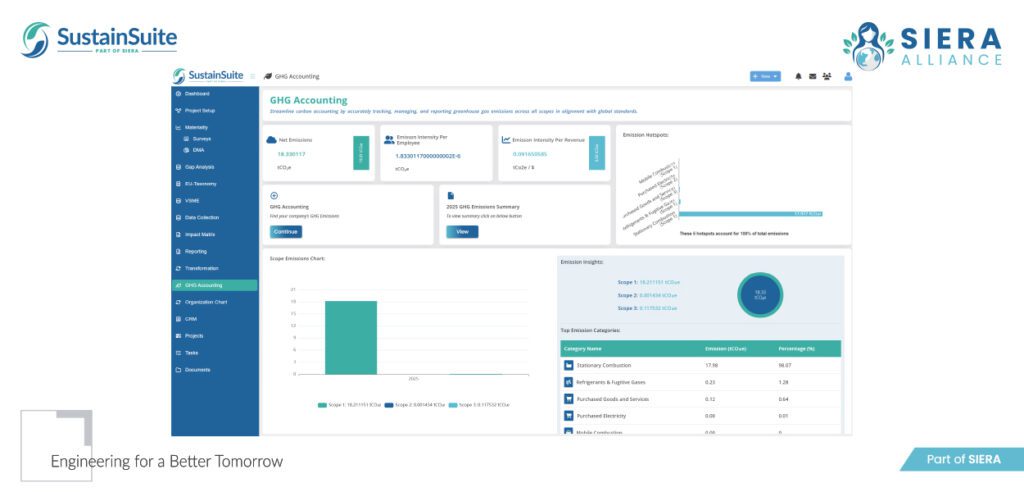From evolving regulatory requirements to growing stakeholder expectations and volatile global markets, businesses can no longer afford to overlook their environmental impact. At SIERA Alliance, we know that any successful corporate sustainability strategy begins with meticulous carbon footprint tracking.
Whether you’re looking to align with ESG reporting standards or identify emission hotspots and set science-based targets, carbon footprint monitoring can effectively future-proof your operations against climate-related risks. But what exactly is a carbon footprint, and why is it important for businesses to track in 2025?
What Is a Carbon Footprint?
A carbon footprint is the total volume of greenhouse gas (GHG) emissions produced directly or indirectly by an individual, organization, product or activity. It’s typically measured in metric tons of carbon dioxide equivalent (CO2e) to account for the varying global warming potential of different gases like methane and nitrous oxide.
Defining the Corporate Carbon Footprint
A corporate carbon footprint refers specifically to the total GHG emissions generated across a company’s operations. These emissions are categorized under:
- Scope 1: Direct emissions from owned or controlled sources (e.g., company vehicles, on-site fuel combustion).
- Scope 2: Indirect emissions from the generation of purchased electricity, heating or cooling consumed by the company.
- Scope 3: All other indirect emissions in the value chain, such as business travel, supplier emissions, product end-of-life treatment and waste processing.
Understanding and managing theses emissions is critical for meeting carbon reduction goals and aligning with the European Union’s regulations.
10 Reasons to Track Your Corporate Carbon Footprint
1. Meet Regulatory and Reporting Requirements
With new carbon reporting mandates and the European Green Deal setting stricter environmental standards, carbon emissions reporting is becoming mandatory for many companies. Tracking your corporate carbon footprint ensures you’re prepared to meet these evolving legal obligations and stay ahead of compliance risks.
2. Enable Comprehensive ESG Reporting
Environmental, Social and Governance (ESG) reporting is increasingly demanded by investors and stakeholders. Carbon footprint tracking supports the disclosures aligned with TCFD, CDP, CRI and CSRD standards.
3. Set and Achieve Carbon Reduction Goals
A clear baseline of your business carbon footprint enables the formulation of realistic and science-based carbon reduction goals. Whether your target is net-zero by 2050 or a 50% cut by 2030, tracking progress is impossible without accurate baseline data.
4. Improve Operational Efficiency
Monitoring emissions can help identify inefficiencies across business operations. For instance, excessive fuel consumption or energy waste in manufacturing can be addressed, leading to both emission reductions and cost savings.
5. Enhance Brand Reputation and Stakeholder Trust
Customers, investors and employees are drawn to companies with a proven commitment to sustainability. Transparent carbon disclosure builds trust and enhances brand value in a competitive market.

6. Attract Investment and Access Green Finance
Many investors are now using ESG scores as a proxy for long-term resilience. Companies that track and report their emissions are better positioned to access green financing opportunities and sustainability-linked loans.
7. Future-Proof Against Climate Risks
As climate risks become more material, from carbon taxes to supply chain disruptions, tracking your footprint helps anticipate and adapt to these challenges, strengthening operational resilience.
8. Drive Supplier and Value Chain Engagement
Scope 3 emissions — typically accounting for the largest share — depend heavily on suppliers and partners. Carbon tracking enables targeted dialogue, collaboration and sustainability interventions throughout the value chain.
9. Support Products and Process Innovation
Understanding emissions hotspots across products or services opens doors for innovation; whether it’s eco-friendly design, low-carbon materials or digitalization strategies that optimize energy use.
10. Benchmark Performance and Track Progress Over Time
Using carbon footprint software, companies can monitor year-on-year performance, benchmark their progress against peers and evaluate the success of decarbonization strategies, ensuring long-term and effective sustainability integration.
SustainSuite Helps You Measure What Matters
Carbon accounting tools are essential for organizations looking to measure, manage and reduce their emissions. These tools range from simple spreadsheets to advanced carbon footprint software solutions.
Modern platforms like SustainSuite streamline this process, reducing the burden of manual calculations and improving data accuracy for compliance and transparency.
Designedto simplify, automate and enhance carbon emissions tracking, this is how SustainSuite supports an organization’s journey toward carbon accountability:
Key Functions
- GHG Emissions Tracking: Measures Scope 1, 2 and 3 emissions across various sources like electricity, transport and supply chain.
- Automated Calculations: Uses a large database of emission factors to calculate CO2e values accurately, saving time and minimizing errors.
- Comprehensive Reporting: Generates reports aligned with major frameworks like CHG Protocol, CDP, TCFD and CSRD carbon reporting requirements.
Key Features
- Emission Breakdown by Scope and Source: Get a clear picture of where emissions are coming from.
- Custom Reporting Templates: Create internal reports, stakeholder briefings or regulatory submissions with ease.
- Data Import Capabilities: Pull in data from utility bills, business travel logs and other sources.
- Modular Design: The GHG module functions independently for emissions-focused users, while allowing integration with broader sustainability tools as needed.
With SustainSuite, you can easily track emissions trends over time and quickly respond to any anomalies, enhancing your resilience against climate-related disruptions. The platform enables you to generate compliance reports at the push of a button, streamlining your reporting processes and reducing the internal administrative burden.
SustainSuite also helps align your emissions data with your broader corporate sustainability strategy, allowing for more informed decision-making and measurable climate impact.


Track Your Footprint, Control Your Future
Tracking your corporate carbon footprint is not just about compliance. From ESG goals to enhanced operational efficiency and stakeholder trust, the benefits are wide-ranging. By integrating SustainSuite into your operations, you’re not just meeting your carbon disclosure obligations — you’re building a future-ready, climate-conscious business prepared to lead in a low-carbon economy.
Start tracking, start reducing and start transforming!
Frequently Asked Questions
1. Why is it important to track carbon footprint?
Tracking reveals trends, supports climate goals and enables timely response to changes. For corporations, carbon footprint tracking is essential to reduce emissions effectively and stay competitive in a low-carbon economy.
2. Does carbon footprint only measure carbon dioxide emissions?
No, a carbon footprint includes all major greenhouse gases — carbon dioxide (CO₂), methane (CH₄), nitrous oxide (N₂O) and fluorinated gases — converted into carbon dioxide equivalents (CO₂e) using their Global Warming Potential (GWP).
3. What is the difference between “net zero emissions” and “carbon neutrality”?
Net zero entails reducing emissions across all scopes as close to zero as possible and neutralizing any remaining emissions with carbon removal. Carbon neutrality, on the other hand, often involves balancing emissions with offsets without necessarily cutting actual emissions.
4. Are global carbon emissions still increasing or are they falling?
Global carbon emissions are still increasing, but the growth rate is slowing. According to the IEA, energy-related CO₂ emissions rose by 1.1% in 2023 — down from 1.3% in 2022 and 6% in 2021 — highlighting progress in carbon reduction programs.





